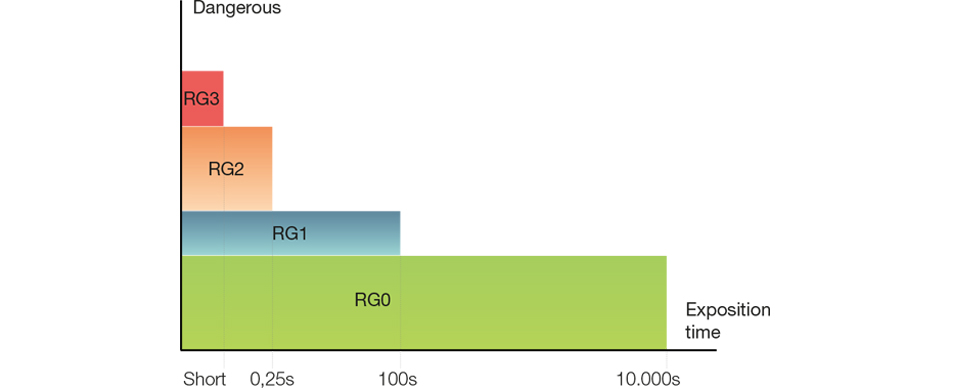Among 3F Filippi’s top priorities is the well-being of those who are illuminated by our products. For this reason, we pay a great deal of attention to photo-biological safety, using the best sources with a low impact on human health.
Unfortunately, some less scrupulous manufacturers use low-quality sources during prolonged exposure, emit radiation which is damaging to organs of the human body, such as the eyes and skin.
A number of Photobiological Safety Risk Groups (IEC62471) have now been defined for the amount of radiation emitted from all sources in the range of wavelengths from 200 nm to 3000 nm, providing a clear indication of the limits of maximum exposure for each group.
In accordance with Paragraph 6.1 of EN 62471: 2010, the risk groups (for blue light) are defined as follows:
- RG0 (Risk Exempt): The source does not cause any photo-biological risk. Requirement met by any lamp that does not cause a blue
light (BL) retinal risk with an exposure time of up to 10,000 s (about 2.8 h). - RG1 (Low Risk): The source does not cause risk due to normal operating limitations on exposure. Requirement met by any source that exceeds the limits of the Exempt Group but does not cause a blue light (BL) retinal risk with an exposure time of up to 100 s.
- RG2 (Moderate Risk): The source does not cause a risk due to an instinctive reaction when looking at very bright light sources (or due
to a sensation of thermal discomfort.) Requirement met by any source that exceeds the limits of Risk 1 Group but does not cause a blue light (BL) retinal risk with an exposure time of up to 0.25 s (aversion response). - RG3 (High Risk): The source can constitute a risk even due to momentary or brief exposure.
- Sources that exceed the limits of Risk Group 2 are included in Risk Group 3.
3F Filippi is committed to providing the most technologically advanced luminaires and always chooses the LED sources with the lowest photobiological risk group available on the market for its customers.
We also frequently find that some manufacturers declare data which is inconsistent with the components available on the market, and which must therefore be untrue.
If customers are offered product solutions similar to those which 3F Filippi declares for a certain class (for example RG1 - low) but other manufacturers state as being of a lower class (e.g. RG0 – risk absent), they can protect themselves by requesting that those manufacturers provide the certificates proving that the sources actually meet this photobiological risk class.The current standard EN 60598-1 concerning indoor luminaires indicates that RG0 or RG1 risk groups are acceptable for safety purposes. With the publication of standard EN 60598-1: 2015 (Luminaires - Part 1: General requirements and tests), the acceptable levels for safety purposes were definitively established.
In Paragraph 4.24.2 (Blue light retinal risk), the following is indicated:
“For luminaires that use light sources from risk group RG0 (unlimited) or RG1 (unlimited), in accordance with IEC/TR 62778, or which have been judged as being finished products ready for use, belonging to risk group RG0 (unlimited) or RG1 (unlimited) , the requirements concerning blue light retinal risk do not apply.”
For luminaires that have an ETHR illuminance threshold, evaluated in accordance with IEC/TR 62778, additional requirements are applied for evaluating how far the product is from the threshold between RG2 and RG1. In such cases, although the luminaire cannot be considered to be dangerous, warnings and markings are used to alert the installer or user to the possible risks associated with direct and prolonged viewing of the source.
From a technical perspective, RG0 and RG1 groups cannot be said to be equivalent, or to be both considered as "exempt". The two photobiological risk groups are in fact distinguished as follows:
- RG0 (Risk Absent): the source does not present any photobiological risk.
- RG1 (Low risk): The source does not cause risk due to normal operating limitations on exposure.
Currently, therefore, there is no regulation that declares the various photo-biological risk groups to be equivalent, or indeed that united them, rendering both exempt.
Exposure to RG1-group luminaires is not considered dangerous under ordinary conditions of use, due to the fact that periods of exposure of over 100 seconds are considered to be "unlikely", although not impossible, as this cannot be predicted in the design phase.
Risk group RG0, on the other hand, has a period of exposure greater than 2.8h and as such, it can be stated with greater confidence that a luminaire would not be viewed directly for this long.
The demand for RG0 light sources could be considered redundant, but it is not stated anywhere that it is prohibited to request the use of RG0 luminaires, or that these can be considered equivalent to those belonging to the RG1 risk category.
As explained above, the RG0 risk group represents a cautionary, optimal class of light source.
A company that exhibits extra caution with regard to the safety of its operators, and decides to install equipment belonging to the riskexempt RG0 category, could therefore be seen to be excessively conservative, but cannot certainly be criticised for having requested compliance with a parameter that provides greater safety for all involved.
European legislation states that companies, specifically the statutory employer, evaluate and manage risks to workers' health and safety.
Among the risks that the employer must evaluate is any photobiological risk deriving from exposure to artificial optical radiation.
The reference standard is IEC/EN 62471:2010, which does not define a threshold marking safe from unsafe, but rather defines classification of sources into risk groups.
Limitations of use or warnings for the user are contained in the corresponding product standards, while a product marking guide is contained in IEC TR 62471-2:2009.




